Saving Lives from Domestic Violence
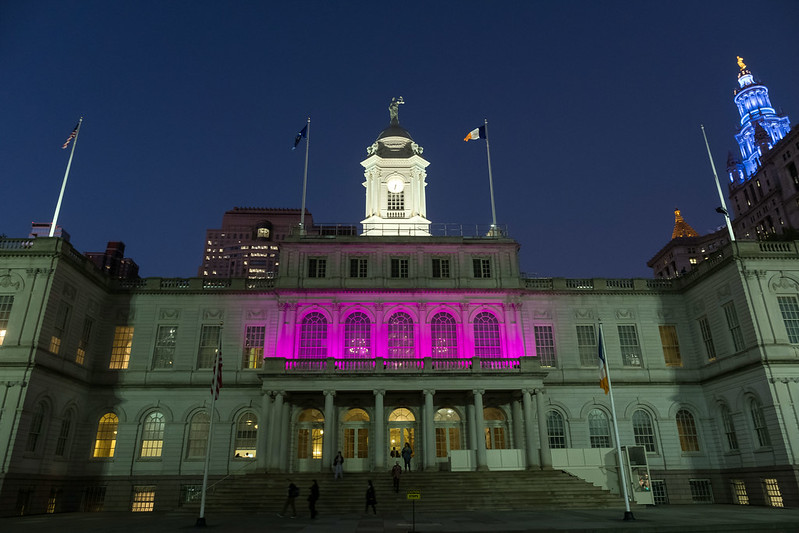
City Hall in purple (photo: Ed Reed/Mayoral Photography Office)
One survivor used the word “red” in telephone calls with her best friend when she and her children were in trouble. A family living with an abuser placed a photo in a window visible from the street – when the photo was not visible it meant they were in trouble. Another survivor signaled for help with a special knock on the wall shared with a next-door neighbor.
As a domestic violence survivor said in “When Staying Home Isn’t Safe,” one of my recent ThriveNYC podcast episodes, “If you can’t be strong, be brave. Go get help.” In her case, she left her partner after the smacks turned into punches. Survivors break through isolation in many ways, as the above anecdotes show.
Domestic Violence Awareness Month is marked every October but COVID-19 has changed everything this year. There have been surges in suspected and reported domestic violence nationwide since the pandemic, with a 19% uptick in calls to New York’s domestic violence hotline since April compared to last year. A New England Journal of Medicine article called domestic violence during COVID-19 “a pandemic within a pandemic” because of a cascade of relationship stressors -- crowded housing, unemployment, illness, isolation, remote schooling and work.
In this moment of protests for racial equality and a higher profile for social justice movements, now is the time for all New Yorkers to become allies in the fight to end domestic violence, which touches 1 in 4 women and 1 in 10 men. Like so many social ills, domestic violence cuts across all demographic lines, exacerbated by factors like racism, homophobia, citizenship status, and poverty.
We can all do much more than wear purple on October 22, a day historically dedicated to raising domestic violence awareness.
Be an “upstander” not a bystander. Learn the signs of domestic violence and abuse by going to our NYC Hope website, and memorize and share the phone number of the domestic violence hotline: 1-800-621-HOPE (4673) to connect to services.
The ThriveNYC helpline at 1-888-NYC-Well is also available 24/7 to talk, text, or chat with trained counselors in almost every language. It is a free and completely confidential place to talk about whatever is on your mind. The city’s Family Justice Centers (a one-stop shop for survivor services) closed temporarily because of the pandemic but services are available by telephone.
Still active is the city’s network of services and assistance for survivors: shelters, food delivery, legal assistance, reimbursement for tele-health mental health services. Links to those services are on the city’s domestic violence support page.
These strange, unprecedented few months have been a time to learn what we can do better. Survivors have told city officials that during the COVID-19 crisis they urgently need survivor-led spaces for peer-to-peer support. So for the first time ever, the city is supporting a series of public, virtual Survivor Town Halls in every borough, with two planned for Domestic Violence Awareness Month. One is on October 15 in Manhattan and one is October 28 in Brooklyn.
Notably, the town halls are organized with grassroots organizations like the Voices of Women Organizing Project, the lead initiative of the Battered Women’s Resource Center.
These 90-minute Zoom calls are an opportunity for networking, story-telling, and resource-sharing with fellow survivors and representatives of such key city agencies as the Administration for Children’s Services, the Department of Education, and the Department of Health and Mental Hygiene. Among topics to be discussed are financial survival, being undocumented, family court, mental health, and staying safe online.
Cecile Noel, Commissioner of the Mayor’s Office to End Domestic and Gender-based Violence (ENDGBV), emphasizes that allies must listen to what survivors need and be respectful of their choices, which might include staying with the person who has abused them.
There is always hope and there is always help. We need every New Yorker to join us in this battle for equality, dignity, and life. In a time of rampant uncertainty, isolation and fear, we are stronger by standing together. As the marches and social justice protests across the country have shown, we can share a different vision for how we treat one another, even in our own homes and our most intimate relationships.
***
Chirlane McCray is First Lady of New York City. On Twitter @NYCFirstLady.
***
Have an op-ed idea or submission for Gotham Gazette? Email This email address is being protected from spambots. You need JavaScript enabled to view it.
What We Mean by Defund The Police
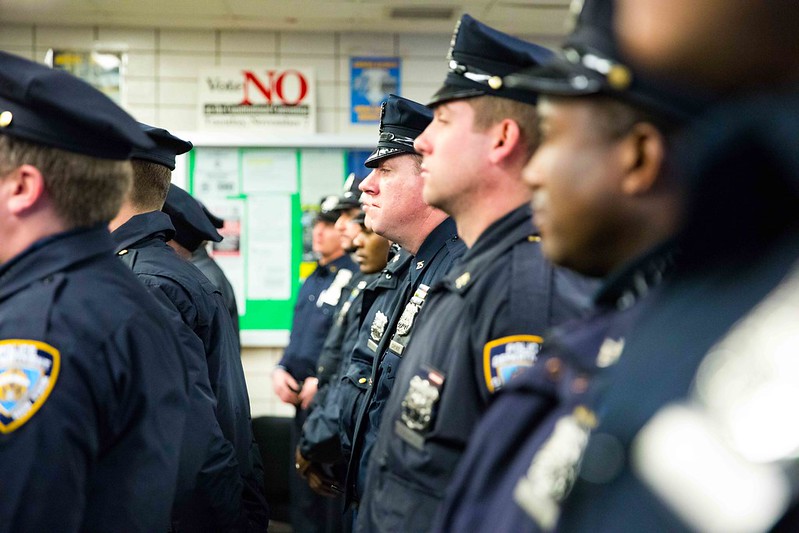
NYPD officers at a precinct (photo: Benjamin Kanter/Mayoral Photo Office)
While there's widespread agreement today about the need to change or improve policing in our country, we fall far short of a consensus about the particular reforms needed. Should the changes leave the basic institutions of policing intact or should they be far-reaching? Should we dismantle current law enforcement structures and replace them with new entities? Or more generously fund existing agencies for promoting safety and justice?
Advocates' analysis is that abusive practices, from egregious incidents of brutality to bogus arrests backed up by "testilying" to daily disrespect and indignities, are so deeply entrenched and long-standing (reaching back to the founding of police departments in the U.S. in the 19th century), that only measures that are radical -- in that they address the roots of the problem -- will suffice to deliver justice.
Most police departments have unchecked power, and as the old shibboleth has it: power corrupts and absolute power corrupts absolutely. Most politicians, even self-identified progressives like Bill de Blasio, will not take meaningful steps to curb the abuses or to sanction many officers whose violence and lawlessness are undeniable, documented by an unending series of hard-to-watch videos.
After Minneapolis police officers killed George Floyd, the movement promoting fundamental change literally swept the country, with street demonstrations and urgent calls for action taking place in virtually every sizable U.S. city, as well as many other jurisdictions. These activities took place under various banners, most often "Black Lives Matter" or "Defund The Police," or both slogans simultaneously. Over time "Black Lives Matter" has grown more popular with a broad range of constituencies. Many mainstream politicians, for example, subscribe to it, adopting the rallying cry and authorizing murals attesting to their support.
"Defund The Police," however, remains highly controversial amongst the public and with numerous public figures, including Democratic presidential nominee Joe Biden, who express discomfort or outright opposition. Biden, in fact, has actually called for increased funding for police.
People's discomfort and opposition are based on their somewhat understandable interpretation that the slogan means the expeditious cutting of all monies for, and the disbanding entirely of, police forces. Also, many Americans think of public safety in terms of what police do or don’t do. Alternative means of curtailing crime and disorder are rarely part of the public discourse, and the fact that many calling to defund the police mean to shift significant sums away from policing and toward social services is often not understood or acknowledged.
Here's what PROP -- the Police Reform Organizing Project, a nonprofit that I run -- means by Defund The NYPD. Our guiding operating principle is to sharply curtail police power, presence, and personnel, mainly because such steps will significantly reduce the department's ability to carry out, and to get away with, abusive and racist practices. Also, through the resulting savings, these measures will make available additional resources to fund effective and benign alternative approaches.
Specific examples include:
Transfer traffic enforcement to another government agency. In 2019, NYPD officers issued nearly 1 million traffic summonses -- why do we need an officer with a gun to pull someone over who's driving a car with a broken taillight?
Disband NYPD units that are notorious for violating the rights and well-being of vulnerable constituencies. Eliminated units would include the nuisance abatement, vice, and peddlers squads.
Have mental health professionals be the first responders to emergencies involving people in psychiatric crises. Now 911 dispatchers have virtually only one option: to send officers, whose instincts and inclinations are often to use force to resolve problematic situations, an approach that far too often results in harm or even death for the New Yorker in emotional distress.
Remove from public schools all NYPD personnel who now outnumber social workers in the system. Let's return responsibility for school safety to educators who can still call on the police in exceptional circumstances.
Additionally, as part of an effort to curb police abuses, New York City should establish an independent prosecutor's office whose sole purpose would be to investigate and prosecute when warranted all alleged acts of police brutality, even when the victim was armed or did not die.
New York City spends over $10 billion annually on its law enforcement apparatus, the bulk of it going to the NYPD, whose practices drive the entire big, bloated system. Our proposed measures would cut expenditures by several billions, funds government could allocate to programs that support the communities most compromised by biased police tactics, for instance: real affordable housing to address our dire homeless problem; smaller school classes that studies show improve academic outcomes for all children across race and class lines; expanded health and mental health services; Cure Violence programs employing credible messengers who divert neighborhood youth from anti-social to productive activities; and public works projects providing jobs and job training to unemployed New Yorkers.
This agenda, manageable and sensible, would go a long way toward eliminating the severe hardships inflicted on vulnerable New Yorkers by our so-called justice system. Perhaps to enhance its political viability, we should consider employing different slogans from Defund The Police, such as: People Before Police; Government Should Help People, Not Hurt Them; or Cut Cops, Build Communities. Maybe they're not as dramatic or pithy as Defund The Police, but they more accurately reflect our worthy goal of creating a just, safe, and inclusive city for all New Yorkers.
***
Robert Gangi is Director of the Police Reform Organizing Project. On Twitter @GangiFromPROP & @PROPNYC.
***
Have an op-ed idea or submission for Gotham Gazette? Email This email address is being protected from spambots. You need JavaScript enabled to view it.
Letitia James Serves as Last Line of Defense Against Trump Administration
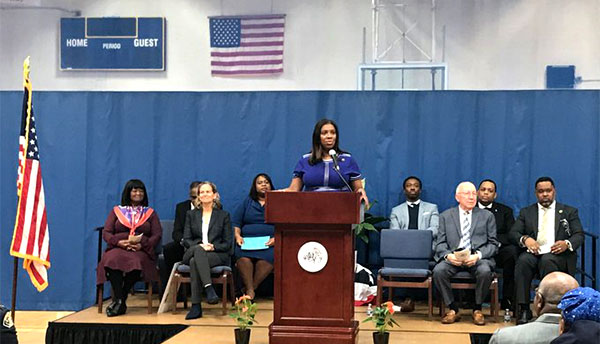
Attorney General Letitia James (photo: @NewYorkStateAG)
In blocking the Trump administration’s attempt to sabotage the 2020 Census, a California court last week handed yet another key victory to the Office of the New York Attorney General. And this is just the latest in a string of triumphs coming from the office of the Empire State’s top lawyer as the president pushes his election-year agenda.
While the president’s rhetoric often translates to the introduction of potentially devastating policies, many of the administration’s most egregious moves have faced successful opposition on the legal battlefield. In large part, that is due to the tireless efforts by Democratic state attorneys general. And New York’s Letitia James has long been in the lead, fighting back the Trump administration’s agenda.
On immigration issues, she has been particularly successful. She led the successful charge to block immigration agents from making arrests at courthouses and filed a lawsuit that pressured the Department of Homeland Security to abandon plans to deport international students during the pandemic.
In another victory for asylum seekers and asylum recipients around the country, a lawsuit filed by Attorney General James blocked an order that would have limited employment authorization for asylum recipients. Her efforts also stopped the increase of fees for immigration related applications. Earlier this month, AG James secured another hard-fought win when a judge ruled in her favor to invalidate regulations that would have stripped workers of labor protections.
While James has used her role as the state’s top legal officer to protect vulnerable communities, that position has been weaponized by conservative attorneys general putting political interests above the public good.
The Trump administration’s frequent political stunts have further underscored the motivational differences between Democrats and Republicans holding the office. Democratic state attorneys general dedicated to preserving this nation’s bedrock principles have built coalitions and banded together to challenge the administration’s efforts to erode the rule of law. The same cannot be said of many Republican AGs, who have joined United States Attorney General Bill Barr in converting their offices into Trump campaign subsidiaries.
James has proven she can take Trump to task and her victories are adding up. In addition to her latest triumph in support of an accurate Census, in June, her office thwarted the administration’s craven bid to exclude undocumented immigrants from the 2020 count.
More than just lawsuits, James’ office carries institutional heft that she has put to use to call out flagrant abuses of power and advocate for increased transparency in law enforcement. This year, that role has been more important than ever. Last week, she joined the chorus of voices calling on Kentucky Governor Andy Beshear to release grand jury evidence in the Breonna Taylor police shooting case.
In addition to fighting for the voice of the people, AG James has rightfully blasted self-serving attorneys general such as Texas’ Ken Paxton, who has used the COVID-19 pandemic to attack reproductive rights. James, on the other hand, has continually backed an agenda to protect women’s rights and expand access to reproductive health care, which has included sparring with Trump and his attempts to reduce options for women everywhere.
Importantly, James hasn’t shied away from investigating the Trump Organization’s financial dealings. A Manhattan judge recently ordered the president’s son, Eric Trump, to comply with a subpoena and sit for an interview with James’ office.
In the coming months, it’s likely her leadership will be needed to combat a new slate of obvious overreach by an administration looking to exploit government powers to exact political retribution and gain. One of the latest attempts to undermine the rule of law: weaponizing the Department of Justice and taking aim at liability protections in order to bludgeon the administration’s perceived political enemies in Silicon Valley.
As the election approaches, New Yorkers will continue to look to AG James to protect democracy’s most foundational institutions. Her office ― time and time again ― has served as a last line of defense against a dangerously partisan president and his team of sycophantic enablers.
I look forward to continuing to support her on her journey to give voice to our most vulnerable citizens and bring justice for all New Yorkers. The future depends on it.
***
Jeremy Sherber is the founding president of Grand Street Democrats in New York City. On Twitter @jsherber.
***
Have an op-ed idea or submission for Gotham Gazette? Email This email address is being protected from spambots. You need JavaScript enabled to view it.
Candidates Eyeing Seats in Albany Should Sign Our Anti-Corruption Pledge
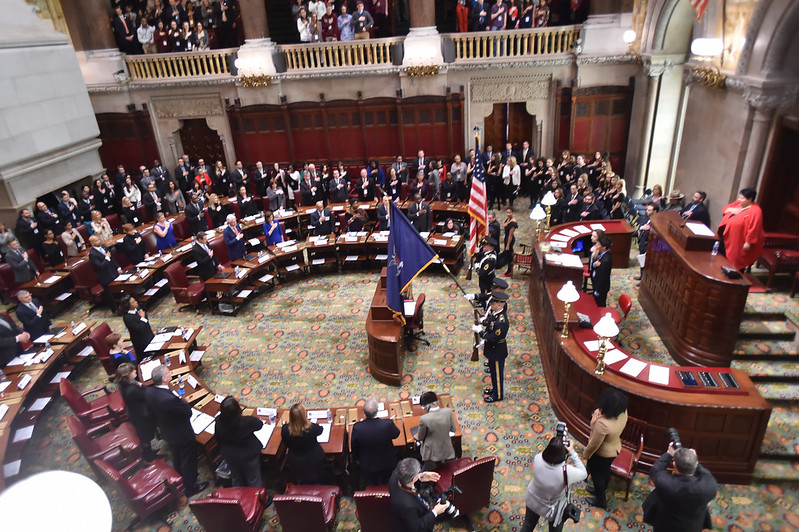
The State Senate (photo: Kevin P. Coughlin/Office of Governor Andrew M. Cuomo)
The presidential election will no doubt get most of the political ink between now and Election Day, November 3, but it’s important to remember that candidates for the state Legislature, including many incumbents and their challengers, are also on the ballot here in New York, the most politically corrupt state in the nation.
Among the most critical powers all state legislators wield is the power to control how elections are conducted and how government officials are held accountable. These “rules of the game” have everything to do with the policy outcomes that we all have to live with. It’s quite possible that all our political corruption is linked to the fact that New York is also number one in economic inequality, with the fewest people taking the biggest share of the money.
We at Represent.Us NY believe now is the perfect time to bring people together to fight for a government that works for all the people, not just the wealthy and connected. We’re asking all candidates for State Senate and Assembly to sign our #FixNYDemocracy pledge and commit to act on corruption in the next legislative session.
We began our campaign before the June primary, and gathered a bipartisan group of 37 candidates across 26 districts throughout New York State, from Buffalo to the Bronx, to commit to democracy and sign the pledge. Fourteen of those signers won their primaries, including but by no means limited to a group of progressive challengers who swept incumbents out of office.
That leaves dozens of incumbents and challengers whose level of commitment to cleaning up New York government remains unclear. Some incumbents may have feared retaliation from party leaders before the primary. But now that many candidates are likely to win safe districts in November, we really hope they’ll feel more free to stand up for what is right and help us build an unstoppable wave of electoral reforms that are so sorely needed here.
The pledge covers three essential issue areas:
1. Fixing New York elections through unbiased redistricting maps, fair ballot access rules, and expanding ranked-choice voting.
Redrawing election districts happens every ten years, once new Census data is out. New York passed a new redistricting process in 2014 that bears little resemblance to the relatively fair, independent redistricting that can be found in some other states. With the statehouse now firmly in Democratic Party hands, that process is still being debated, and could be in play well into next year. Also, last year Gov. Cuomo oversaw a process that made our ballot access rules the most restrictive in the nation, an existential threat to so-called third parties. This effort is still in the courts, but could affect 2021 elections.
2. Getting big money out of New York politics with lower contribution limits. New York’s political campaign contribution limits have been lowered, but remain among the highest in the nation.
3. Holding officials accountable through a truly independent ethics watchdog. The current commission, JCOPE, is weak and there have been efforts afoot to change it through legislation.
We need more elected officials who make decisions based on what is right for the people, rather than what big donors or a corrupt system pressure them to do. They must have the independence and courage to take on inequities further exposed by the COVID-19 pandemic and the movement against police brutality.
As Zohran Mamdani, a candidate for state Assembly in Astoria, Queens who won his recent primary winner over an incumbent legislator, said, “We’re in the midst of many crises but it’s important to know that they began long before this pandemic. For years, landlords, lobbyists and police unions have bought our elections and controlled our politics – and our politicians.”
Mamdani stands with Represent.Us NY to #FixNYDemocracy, get big money out of New York politics, and tackle inequality.
Represent.US NY continues to collect signatures on the pledge, and will do so until just before Election Day. Voters should contact their elected officials and local candidates and demand that they sign the pledge.
***
Karen Young is a volunteer with Represent.Us NY, the Empire State Chapter of Represent.Us, the nation’s largest grassroots, nonpartisan anti-corruption organization. On Twitter @RepresentUsNYC.
***
Have an op-ed idea or submission for Gotham Gazette? Email This email address is being protected from spambots. You need JavaScript enabled to view it.
Advice for the Next Mayor from a Veteran of the City Hall Trenches
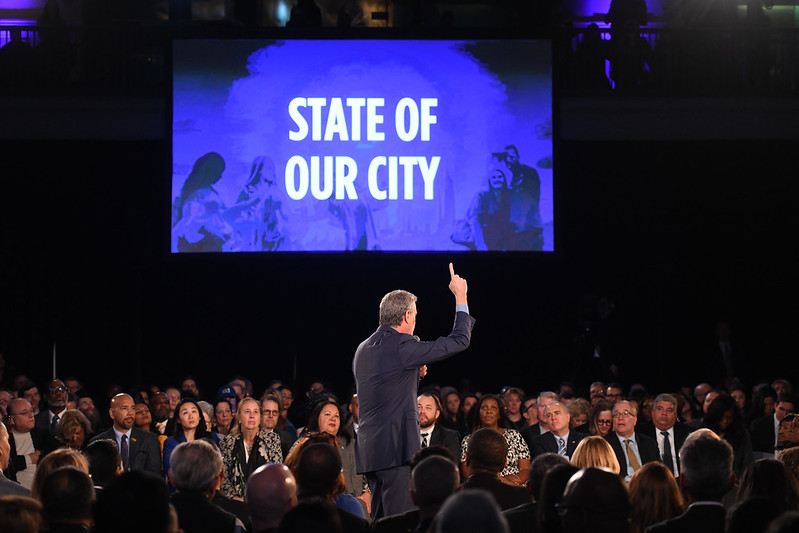
State of the City 2020 (photo: Michael Appleton/Mayoral Photography Office)
New York City is at a crossroads. As our response cautiously shifts to recovery, we will have an equally important responsibility to reimagine the promise of the greatest city in the world. While Bill de Blasio has a year to jumpstart that progress, it will largely fall to the next mayor to make it happen.
I helped grind the gears of City Hall for three years under this administration. I saw a lot that worked and a lot that didn’t. With the 2021 mayoral race quickly taking shape, here’s the advice I would give whoever is elected to write one of the most important chapters in our city’s history.
Have a strong chin. Nobody escapes City Hall unbloodied. The legacies of Koch, Dinkins, Giuliani, and Bloomberg needed heavy polishing in the years after they left. De Blasio’s will, too. The second hardest job in American politics is not for people who need to be loved. Being mayor is a service-delivery job and people are never satisfied with their service. Test scores go up and crime goes down because of teachers and cops. Schools lag and crime climbs because of you. This is it for your political career, so smile and do the right thing.
Think big. One in five New Yorkers is out of work. Safety, tourism, transit, and tax revenue feel less reliable than they have in two decades. We can’t count on Albany or Washington for help. Incrementalism will not restart our economy and pragmatism alone will not restore faith in our city’s future. We need a big thinker capable of reimagining some foundational elements of our city’s physical and economic landscape to meet this moment. If you’re not ruffling some feathers, you are not thinking big enough.
Be strong and sometimes wrong. Politicians in search of perfect triangulations that make everyone happy fail in New York City. So do those toiling to perfect bulletproof fixes to intractable problems. New Yorkers, and our media, reward courage and confidence – even if that decisiveness means a few more swings and misses. Manage to make lots of good decisions rather than a few great decisions. When you get it wrong, own it. It will be a welcome reminder to New Yorkers that you don’t think you're perfect.
Do not touch animals. The media love animal stories because people love animals. Don’t take the bait. Cradling groundhogs and relocating wayward deer seem like easy wins right up until the moment they are not. Animals only die. Except rats, which you will never be able to kill to anyone’s satisfaction. If you want a friend in politics, get a dog. Just don’t pet any.
Redistribute wealth without dividing people. You don’t have to be a fan of our rigged economy to be a fan of wealthy New Yorkers’ contributions to our city. Good politicians are great at picking villains to harpoon. Those who do it best avoid targeting whole classes of people. We are going to need everyone at the table for this recovery, especially those with resources to leverage. Let’s leave a light on for them so they can help pay the bill.
Understand moments – and how to see past them. Twitter isn’t real life. Your city wants better cops, clean streets, safe and improving schools, and a sharp plan to reduce homelessness. Each week will offer a new challenge that someone smart will say is legacy defining. It almost never is. The subjects on your final report card will be much more conventional than anyone ever says. Have a nose for movements and moments, but don’t be held captive by them.
Don’t argue with the refs. New York City reporters are the most aggressive and talented in the world. Like any good New Yorker, they are colorful storytellers. Coverage of you will range from aggravating to downright unfair. The good news is that you don’t need to waste your time fighting them. Right or wrong, people won’t care about your gripe. New Yorkers read, watch, and listen to reporters we like. Fight with our favorites and you’ve made yourself the enemy.
Manage as an ideology. Being mayor is three things. It’s earning and leveraging public opinion to accumulate power you can spend on things people want. It’s knowing how to move things – mostly trash, snow, people, and money. And it’s being able to square lots of diffuse data and history in making more tough decisions in a day than corporate CEOs make in a month. Doing those three things well is about managing your agenda, your time, and your financial and human resources against a clock. You must enjoy making sausage to make good sausage. You won’t get the results you want if your heart is the only thing pointed in the right direction.
Live like us. We know your schedule is busier than ours. The least you can do is occasionally survive the city like we do every day. Take the subway. Ride a bike or a bus. Go to bars not in midtown hotel lobbies. Sit in the cheap seats. Break out of the rose-colored bubble that will grow around you. You get a mansion, bodyguards, unlimited staff, and a front-row seat to the greatest show on earth. Walking a few minutes in our shoes is a decent way to show some thanks.
New York City is a circus that needs clowns. You can’t make a point in New York City’s public discussion without a personality – even when you run City Hall. Champion the things that we love and hate the things we hate. Chase ambulances to tragedies and heroes. We reward outsize characters and even some big egos. We covet personal flaws and self-deprecation. If you are a mayor who can’t laugh when you’re the butt of the joke, the joke will always be about you.
***
Eric F. Phillips is a crisis communications and media relations consultant. He was Mayor de Blasio's longest-serving press secretary, from 2016-2019. On Twitter @EricFPhillips.
***
Have an op-ed idea or submission for Gotham Gazette? Email This email address is being protected from spambots. You need JavaScript enabled to view it.
Health Care Heroes Had Our Backs. Now We Must Have Theirs
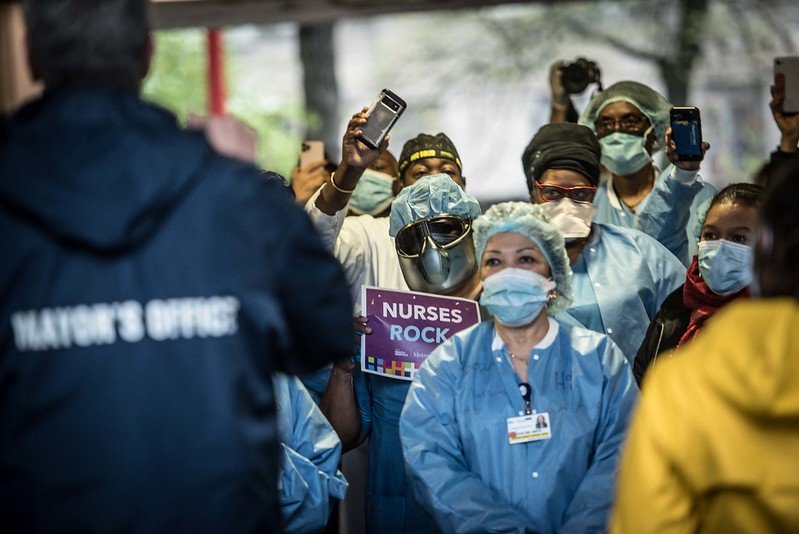
Honoring health care heroes (photo: Michael Appleton/Mayor's Office)
Roars of applause, cheers, and clanging of pots and pans – the familiar 7 p.m. signal in New York for many bleak early spring days of 2020 quickly became a daily ritual in fervent support of health-care workers on the front lines of the COVID-19 pandemic. While most watched the wave of infections unfold through the media from the safe havens of their homes, health-care workers went to work hoping, praying, and questioning the chance of infection and survival for themselves, their families, and their patients.
Jarring stories from intensive care units and reports of suicide among clinicians demonstrated that our claps and recognition were not enough to sustain their well-being. In a new normal where the present and future of this pandemic remain uncertain, we must prioritize mental health services for our front-line health-care workers.
The unknown aspects of the COVID-19 virus presented unprecedented challenges for health-care staff, especially in the outbreak’s epicenter, New York. Lingering uncertainty and a heightened sense of anxiety were fostered by extensive media coverage and a declared state of emergency. The rapid call to response for clinicians set forth a range of obstacles including unmanageable patient loads, providing care outside their skill sets, and witnessing firsthand the growing illness and morbidity rates among coworkers and patients. Health-care workers were living in a constant state of fear and psychological stress, rooted in the risk of transmission of the virus to others and inability to save patients despite their efforts.
While the added sources of stress may have subsided after the city’s immense wave of infections, for many health-care workers, mental health issues stemming from these experiences can and, for many, will persist long after the peak of the pandemic.
The negative mental toll on health-care workers from COVID-19 and previous pandemics is well documented. An analysis published by British Medical Journal of SARS, H1N1, MERS, Ebola, COVID-19, and other pandemics found that staff working directly with infected patients reported higher levels of distress, burnout, and post-traumatic stress. In a systematic review of COVID-19-related studies, insomnia, depression, and anxiety were also reported among health-care workers. Factors such as inadequate personal protective equipment (PPE), risk of infection among medical staff, long hours, and lack of organizational support were noted to contribute to adverse psychological outcomes. These results enforce the growing evidence of mental health challenges among health-care workers treating patients with COVID-19.
Health organizations must promote a culture of caring and psychological wellness to protect the long-term wellbeing of their staff. Experts recommend that leadership can help normalize a focus on mental health needs by providing models for self-care and help-seeking behaviors, and establishing opportunities for staff to share concerns for themselves, colleagues, and patients in a safe and anonymous way.
NYC Health + Hospitals, the city’s public hospitals system, has led the way by establishing partnerships to provide mental health support to health-care workers and first responders on the frontlines of the pandemic. This is an opportunity for other health-care organizations to follow suit by ramping up mental health and wellness programs for employees and sustaining comprehensive support services post-crisis.
In the United States, providing mental health services for clinicians is not a standardized practice. With the COVID-19 pandemic disrupting so many facets of the health-care landscape, health organizations have largely prioritized immediate needs, such as patient care coordination and acquisition of necessary equipment, over mental health. In the aftermath of the most devastating period, the provision of mental health support services will be especially crucial for health-care workers to combat both the short- and long-term effects of stress endured during the worst of the pandemic and into the months of its persistent presence. As the potential for a second wave looms, it is imperative for health organizations to implement effective measures to preserve the mental well-being of their staff.
Now more than ever, proactive and longstanding changes to health-care infrastructures are necessary in order to normalize and integrate mental health services for staff on a routine basis. Recognition alone will not suffice as the future recurrences of the COVID-19 pandemic remain ominous. We owe it to the heroes in this fight to support their recovery and ensure they can continue providing quality care for whatever may come our way. Our lives depend on it.
***
Sandra Carlino Oliveri is a Quality Improvement Specialist at Memorial Sloan Kettering Cancer Center and an MPA Candidate at the NYU Robert F. Wagner Graduate School of Public Service.
***
Have an op-ed idea or submission for Gotham Gazette? Email This email address is being protected from spambots. You need JavaScript enabled to view it.
New York City Schools Need a Trauma-Informed Approach to Student Behavior
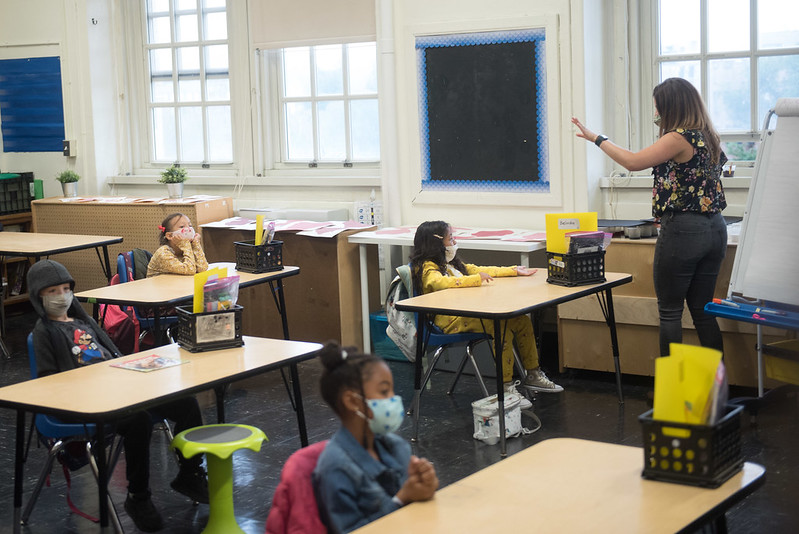
Students return to schools (photo: Michael Appleton/Mayoral Photography Office)
Black, brown, and indigenous students are suspended from school more than any racial or ethnic groups in the United States. This disproportionality exacerbates educational inequities. By controlling misbehavior, rather than correcting it, excessive school discipline has lifelong negative impacts on well-being, academic, and professional success.
The long-term consequences of racially-biased discipline in schools will be even more devastating in a school year as unique and challenging as this one, when the most fragile children, with the greatest need, will return to schools that are chronically under-resourced.
Too many children of color already suffer the irreparable harm of racism and its related diseases, such as poverty, chronic illness, housing instability, and excessive punishment. Today they are experiencing heightened anxiety and depression as the coronavirus decimates their communities and they are isolated from their friends and usual support networks. They are understandably fearful as their parents lose their jobs and struggle to keep their home. Too many are grieving the loss of loved ones and caregivers.
As young people return and acclimate to their COVID-19-modified classrooms, their existing trauma and mental health struggles will become apparent. Teachers are accustomed to the usual jitters associated with the “back to school” transition from summer recess; this year we must be prepared for so much more. Grief and anxiety will manifest in a multitude of ways. Some children will act out. Others will withdraw. All this, in the context of new rules and pressures to wear masks, wash hands, keep distance from friends and teachers, and more. How can we enforce these mandates without penalizing students? Will we be punishing, or act supportively and sensitively? What is our track record?
Given that the New York City Department of Education has not provided guidance on disciplinary practices, schools are being left to determine appropriate protocols individually.
As parents, educators, and neighbors, we must respond with empathy, kindness, and equity above all else. Children need the opportunity to reflect upon their actions and work through the struggles they may be experiencing. If a parent or teacher immediately reacts angrily toward a child without examining context, a child is likely to become even more confused, afraid, or withdrawn. Adults are anxious too, complicating the response.
Make no mistake: responding to a child’s trauma with punitive action will cause harm. It will re-traumatize the child and compound suffering in an already painful circumstance.
Children get their cues from adults, especially during times of extreme stress. They look to us for guidance on how to navigate unusual experiences. Our behavior sends particularly important messages at times like these. When a child “misbehaves,” it’s almost never malevolent. Meltdowns, outbursts, or aggressive gestures signal an underdeveloped ability to deal with transition, disappointment, or disagreement. Misbehaviors may also be signs of trauma. That’s why it’s important to respond by asking the child questions about what they are experiencing in the moment, encouraging them to articulate what is underneath their fear, angst, or reclusion.
Teachers across the country are rightly asking for training on how to support and work with traumatized children. Caregivers should likewise feel empowered to lean on external support systems. At JCCA, for example, we offer individualized family therapy and support services for any family on Medicaid, and already serve over 17,000 children in New York. Parents should also look to mental health counselors and social workers embedded in their schools, who are available remotely to help a child and their family work through the avalanche of challenges stemming from COVID-19.
The pandemic poses many challenges to educators, students, and families. At the forefront should be the challenge of how to address and heal the inequities of our school system—not perpetuate them.
Supportive resources are accessible to parents in well-funded school districts, but scarce in the communities hardest-hit by COVID-19; we must marshal every advocacy and funding opportunity to correct this inequity. In the meantime, all of us can help prevent moments of duress by proactively checking in with kids, asking how they are feeling and affirming the sources of support they can rely on.
As children return to school, we cannot underestimate how the pandemic has turned their world upside down and how it will continue to affect them in the months ahead, especially for students of color. How we respond to their pain in this moment will leave a lasting imprint on their lives, and on the strength of generations to come.
***
Ronald E. Richter is CEO of JCCA. On Twitter @RichterJCCACEO.
***
Have an op-ed idea or submission for Gotham Gazette? Email This email address is being protected from spambots. You need JavaScript enabled to view it.
Affordable Housing is the Key to New York’s Recovery
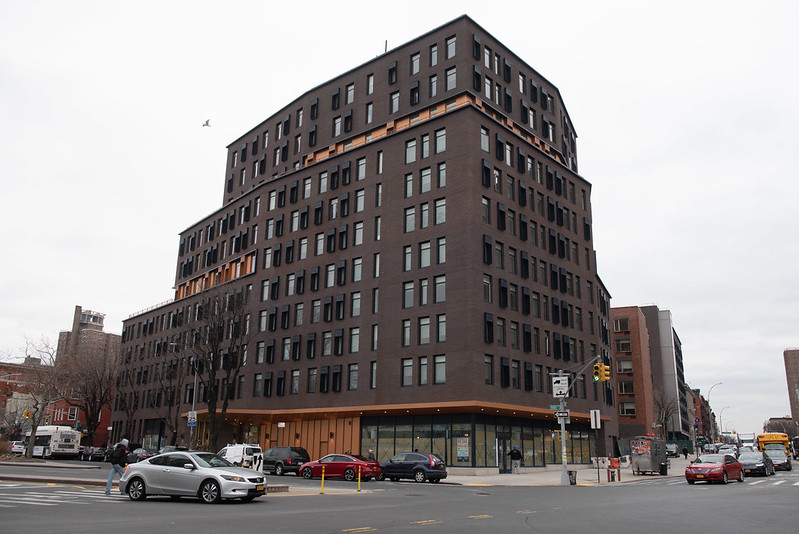
Housing is essential to the city's recovery (photo: Michael Appleton/Mayor's Office)
As we begin yet another month of the pandemic, New Yorkers are alarmed at the acute rent crisis crippling our city. While statewide executive orders temporarily postponing evictions help for the moment, unemployed tenants are building up unpaid rent debt that they will struggle to pay even after they begin working again. And even before COVID-19, more than half of city renters were paying more than a third of their income in rent, and a third of city renters paid more than half their income in rent. While this was never sustainable in the long run, it is now a major obstacle to achieving the recovery New York desperately needs.
The city has been facing an affordable housing shortage for over a century. The virus has put into stark relief that this scarcity impacts not only lower income residents but also the vital middle class. So as we look to recover, we can – and must - make our communities stronger and safer by investing in housing that people can afford as opposed to barely scraping by. Not only will this create jobs that are desperately needed, it will also mean more money in our local economy for the small, local businesses that need our support more than ever.
This is why New York City must embrace New Deal-style economics, starting with an affirmative policy of “Housing First,” focusing both on helping New Yorkers with housing insecurity and also moving people out of the expensive, unpopular, and unhealthy shelter system. Beyond the direct benefits dramatically expanding stable, affordable housing will also improve outcomes for people facing substance abuse, mental health, education deficits, or lack of medical care.
To achieve this, we need a multi-tiered approach that includes community-driven, 100% affordable housing upzonings in areas that have been overlooked.
We need to review the Inclusionary Housing program to consider increasing the percentages of affordable units and use an affordability standard that is not based on a misleading “Area Median Income” that averages low-income communities with ultra-wealthy places like the Upper East Side or Westchester County.
Any new housing on NYCHA land must be built with the support of NYCHA residents, and it must be for 100% affordable housing, not luxury housing that will have almost no impact on the $40 billion backlog in repairs public housing needs.
Overall, we need to take every opportunity to finance and build new affordable housing. And I know we can do it.
On Manhattan’s Community Board 9, I joined in advocating for 200 units of affordable housing in the Hamilton Heights neighborhood of West Harlem as part of a landmark redevelopment, saving a piece of history in the RKO Theater at 146th Street and Broadway. I also pushed City Planning to allow the construction of 300 units of affordable housing in Manhattan Valley above the Con Ed substation at 110th Street and Amsterdam. Both projects will be 100% permanently affordable housing, and if realized, will provide new homes for over 1,000 residents in the 7th City Council District.
We need a complete survey of unutilized or underutilized land and air space, and we need to aggressively determine what is suitable for new Mitchell-Lama style, 100% affordable housing, and then we need to build it.
Affordable housing is a century-old problem for New York, but in this moment, we have a unique opportunity to address this need with actions that can also help restore the economy as our city suffers like never before. It’s time to invest.
***
Dan Cohen is a candidate for City Council in the 7th district, an affordable housing advocate, and community leader. On Twitter @DanCohenNYC.
***
Have an op-ed idea or submission for Gotham Gazette? Email This email address is being protected from spambots. You need JavaScript enabled to view it.
Rebuilding A Stronger, Healthier New York Through Science
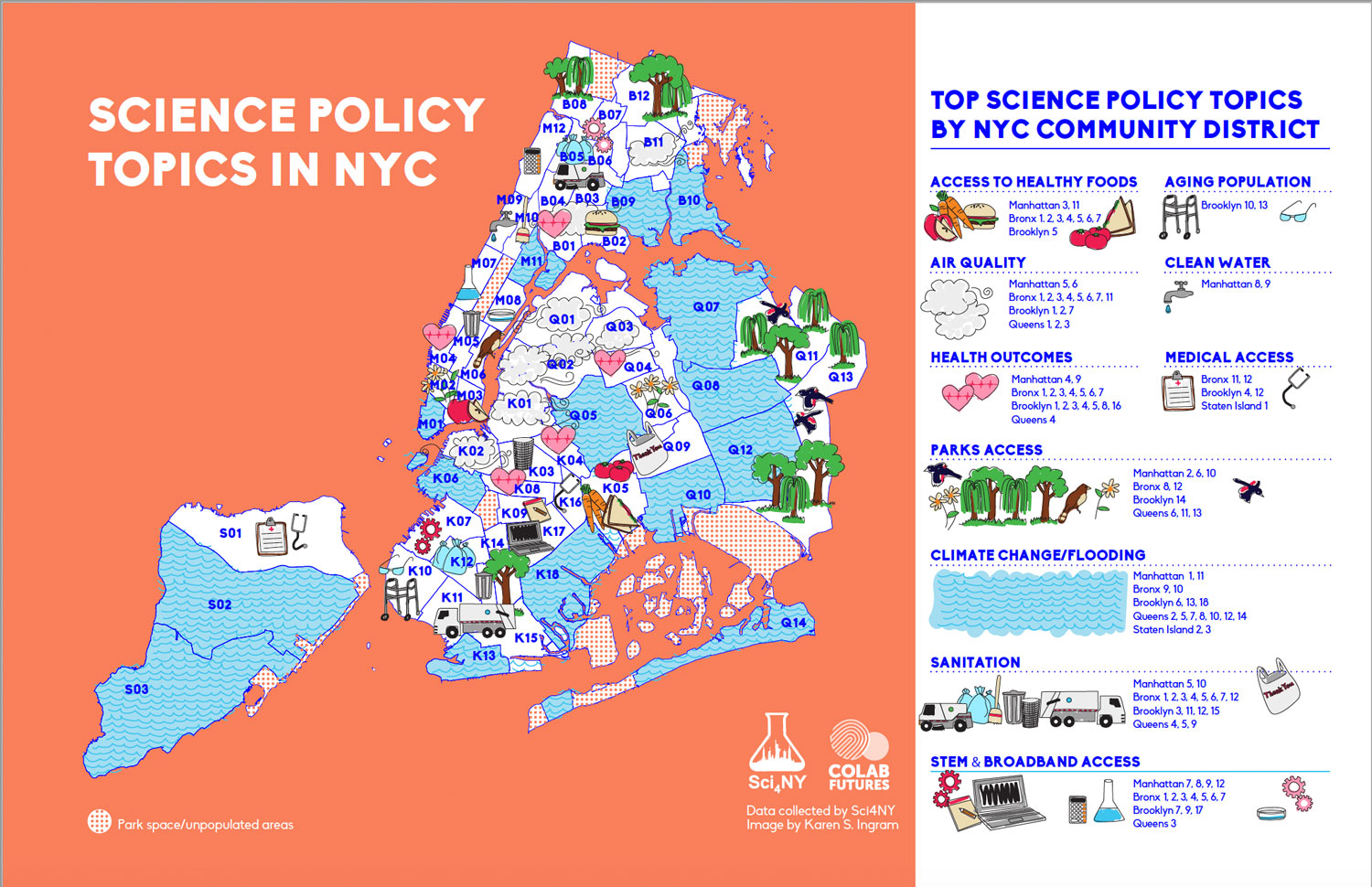
Mapping community concerns that science can help address
Any true New Yorker knows the question is not if New York City will rebuild from COVID-19, but how and when. In order to genuinely build back a better, more sustainable, equitable, and resilient city there has never been more need for effective partnerships between communities, government, and experts.
Science for New York aims to overcome these challenges on a local scale in New York City. We are scientists who volunteer our skills to translate technical and analytical information into meaningful, policy-focused recommendations aimed at increasing the well-being of the city and its residents. While COVID-19 took an enormous toll on our city, including shutting down academic research laboratories, it provided the opportunity for us to redirect this important human capital toward civic engagement work.
One project mapped publicly available data and public input from New York City’s 59 community boards to highlight science-related inequities across the neighborhoods. Your community might be most concerned about sunny day flooding, broadband availability for remote learning, or access to more medical care. Neighborhoods with lower numbers in key socioeconomic metrics had multiple issues that could benefit from scientific support. Our goal was to use the map as science policy outreach to City Council candidates and community organizers.
We reached these key stakeholders through 21 in ’21, an organization striving to achieve gender parity in the New York City Council through the 2021 city elections. Science for New York (Sci4NY) hosted a summer workshop series for its members on how science-based issues including COVID-19, climate change, health, and STEM education impact New York City. The most important lesson we learned from this engagement activity is that our ability as scientists to meaningfully and rapidly identify and synthesize data is very valuable to candidates working to address these issues in their local communities. Currently we are providing support to candidates and community organizers in areas such as maternal and newborn health disparities, green roofs, urban farming, foster care, and climate equity.
Beyond the projects related to the science policy map, Sci4NY has piloted a number of other collaborative projects in the city. These include: lending technical input on pesticide legislation; better ways to improve composting to reduce greenhouse gas emissions; and ways to identify climate change knowledge gaps in order to improve community resiliency. We also worked to bring local policymakers and scientists together at events to learn from each other and simply interact more.
A recent, successful example of having local communities and scientists work together to solve complex issues facing local communicates comes from another equity-challenged city: San Francisco. In April, a coalition called Unidos en Salud recruited hundreds of volunteers to run one of the largest “test to care” coronavirus studies to reduce COVID-19 transmission in the city’s disproportionately affected low-income Latino communities. Since many community members could not work from home, local volunteers worked in tandem with medical professionals and scientists to greatly improve testing. Government officials helped with mobilization, including relaxing requirements for staffing diagnostic labs. In four days, over 4,000 people were tested. Those who tested positive were given care.
In the research community, we have an approach called team science, where groups of academics with different expertise and backgrounds come together to produce solutions, balance contrasting viewpoints with evidence, and develop new ideas. We see particular reason to use this effective approach to tackle some of New York City’s largest challenges. At the same time, we fully acknowledge that many smart and highly-capable people already work on these issues in New York City. Therefore, we strive to not replicate, but rather, amplify existing efforts by integrating our scientific skills to address community knowledge gaps and enhance the overall policy process.
We are confident that many world-class scientists will continue to flock to the city’s academic institutions, eager to explore New York City’s diversity, inspiration, and innovation. As they express their desires, like those scientists before them, to help build a better society, we’ll be here to show them a path forward. Three years in the making and counting, Sci4NY remains committed to developing the collaborations that will rebuild a stronger, healthier New York City for all.
***
Kristin R. Anderson is a postdoctoral research fellow and holds a PhD in Neuroscience, and a member of Sci4NY. Arthee Jahangir is a co-founder of Sci4NY and holds a PhD in Biomedical Sciences. Nancy Holt is a co-founder of Sci4NY and holds a PhD in Physical Chemistry.
Sci4NY can be reached at This email address is being protected from spambots. You need JavaScript enabled to view it. and on Twitter @Sci4NY.
Above map was created by Karen Ingram, an indie Creative Director who focuses on science communications and a cofounder of CoLab Futures.
***
Have an op-ed idea or submission for Gotham Gazette? Email This email address is being protected from spambots. You need JavaScript enabled to view it.
The Mayor and Governor Must Save Community Nonprofits to Save Lives and Livelihoods
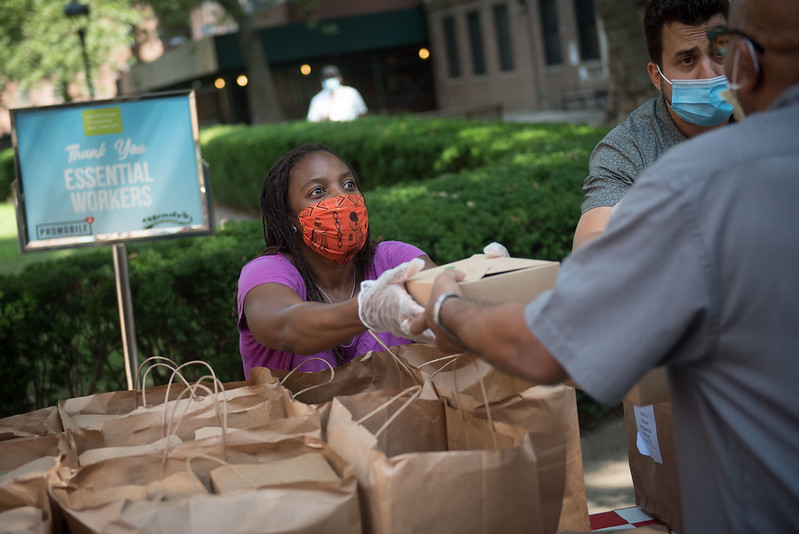
Essential workers need help (photo: Michael Appleton/Mayoral Photography Office)
The COVID-19 pandemic is not just a medical problem—it's a social one. As everyone knows, it is caused by the new coronavirus, SARS-CoV-2. But it is fueled by inequity. Black and Latino New Yorkers have been twice as likely to die from COVID-19 as their white neighbors because of a raft of social factors: People of color are more likely to live in overcrowded housing that makes social distancing impossible, have jobs as "essential workers" that makes working from home impossible and increases their chances of exposure to the virus, and lack access to health insurance and health care that could help them if they fall ill.
So-called social determinants of health also play a role in the underlying medical conditions known to raise the danger posed by COVID-19. Inadequate access to nutritious food may lead to diabetes and hypertension, poor housing conditions are linked to asthma, and chronic stress (like that caused by food insecurity, discrimination, and housing instability), weakens the immune system. Social disparities are a major cause of avoidable medical conditions, and those conditions made poor communities and people of color more susceptible to the first wave of COVID-19.
The social dimension of COVID-19 means that medical providers cannot fight the pandemic alone—they need the help of the nonprofit human services sector if they are going to save as many lives as possible. Human services organizations run the food pantries, deliver assistance to seniors, operate shelters for people experiencing homelessness, support survivors of domestic violence, and provide mental health services for those in crisis. But tragically, in New York, many of these nonprofits face an existential threat because of recent policy decisions at the local and state level.
These organizations derive the majority of their funding from contracts with the New York City and State governments. But this July, Governor Cuomo issued an executive order that allows the state to delay payments to nonprofits that are delivering services like food assistance and homeless shelter. Further exacerbating the problem, this summer Mayor de Blasio and the New York City Council approved a budget that cut funding from the city budget designated to retroactively reimburse nonprofits for their indirect costs.
Even before these moves, many human services organizations were already approaching a breaking point, thanks to city and state contracts that have long been chronically underfunded. This includes payment rates that don’t cover the full cost of programs and delays in payments for services provided. In April, a survey of New York nonprofits by the New York City Employment and Training Coalition and the Human Services Council found 64 percent of organizations believe they will have to reduce service offerings in the future, and 70 percent believe they will need to lay off staff due to budget shortfalls. A July analysis by the nonpartisan organization Candid concluded that 1,800 of New York’s nonprofits could ultimately go out of business due to COVID-19, ranking New York among the ten states in the country that could see the most nonprofits close on a per capita basis.
New York’s finances are indeed in a precarious position, but it is foolhardy to balance our state and local budgets by destroying the very organizations we need most for recovery.
To rein in this pandemic and prevent future ones, New York’s policymakers need to fund the organizations with the knowledge and ability to address the social disparities that grind down the resilience of New York’s citizens. Mayor de Blasio and Governor Cuomo need to honor their financial commitments to nonprofits. The state must pay for the services it has contracted for, and the city must follow through on promised reimbursements for services that were delivered last year.
New York’s human services organizations are calling 911. If we want a healthy city and state, it’s time to answer.
***
Udai Tambar is vice president for community health at Northwell Health. Michelle Jackson is the executive director of the Human Services Council of New York (HSC), an organization representing nonprofit human service organizations across New York.
***
Have an op-ed idea or submission for Gotham Gazette? Email This email address is being protected from spambots. You need JavaScript enabled to view it.
The Unexpected Way to Make Your Vote Actually Matter in New York This Presidential Election
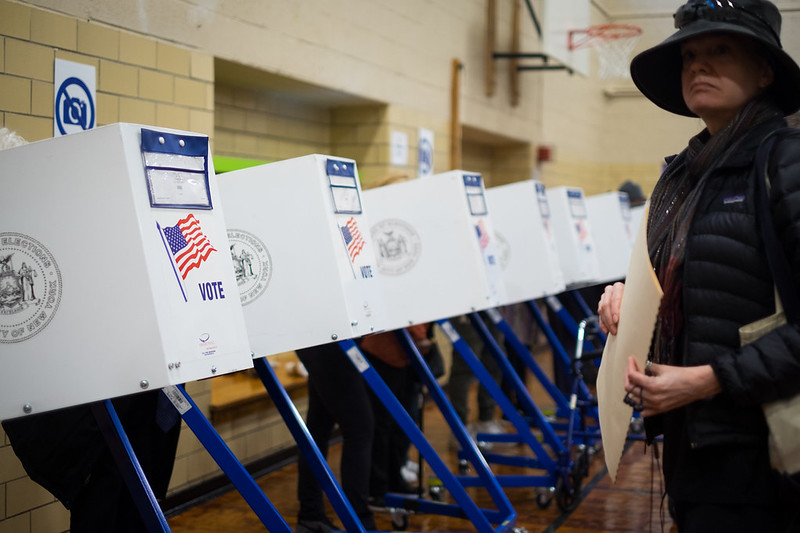
Voting this fall is set to commence soon (photo: Edwin J. Torres/Mayoral Photo Office)
There’s one simple reason why New Yorkers should vote for the Libertarian ticket for President this year: it’s the most effective, real, and tangible way to support democracy.
Earlier this year, Governor Cuomo and the Legislature unfairly raised the barriers for third parties to appear on the ballot in New York State. Your vote for Dr. Jo Jorgensen, the Libertarian candidate for President, can help thwart Cuomo’s goal of depriving New Yorkers of any real choice beyond “the Democrat” and “the Republican.”
This is important. Here’s why.
First, we must recognize that New Yorkers’ presidential votes do not matter in 2020. This is not an insult. Joe Biden is favored to win the state 99 to 1 and the latest poll has Biden up 31 percent on President Trump. Under our electoral college system, New York’s 29 electoral votes will all go to Joe Biden. The ultimate number of individual votes Biden and Trump receive makes no practical difference.
Second, in April of this year, at the height of the COVID-19 pandemic, Cuomo inserted into the state budget a law to effectively kill third parties. The law increases the number of votes and signatures it takes to get onto the ballot and to stay on, securing a ballot line on which to nominate candidates. In New York, unlike in other states, a political party has only one route to get onto a state-wide ballot: it must gather enough valid voter signatures over six weeks to petition its candidate onto the ballot on its party line. Once on the ballot, if the party’s gubernatorial candidate garners enough votes, the party gets to avoid petitioning and operate as normal—so long as its gubernatorial candidates keep garnering enough votes every four years.
Until April, this meant 15,000 signatures and 50,000 votes for governor. The new law makes three changes that render this already difficult process much more onerous: First, it triples the number of signatures to 45,000. Second, it raises the number of votes to 2% of the total vote or 130,000, whichever is greater. (Recent presidential elections show that 2% is around 160,000.) Third, it applies these new thresholds every two years to presidential and gubernatorial elections, not just every four years to gubernatorial elections as in the past.
This new law is not fair. The commission that first conceived these changes in 2019 before its recommendations were struck down as unconstitutional claimed that the increase was to account for population growth since the 1930s, but that would result in only a 1.27% vote threshold or about 100,000 votes.
In reality, nothing explains the vote threshold the commission came up with, the tripling of signatures for petitioning without any extension of time for collection, or doubling the frequency for qualification—except as an attempt to save the Democratic and Republican Parties the inconvenience of having third parties in the general election. Third parties (except for the Conservative Party, which only cross-endorses certain Republicans) don’t generally meet this new threshold, and the new, nearly impossible petitioning threshold will keep them off the ballot or bury them in busywork to neuter their effectiveness.
No believer in democracy and voter choice should support this law. Most of the third parties in New York have sued to stop it, despite our limited resources, though it’s not looking good.
But you can save us! If you are willing to part with your symbolic vote for Biden or Trump and cast it instead for Dr. Jo Jorgensen, you can make a real difference and save ballot access for the country’s third-largest party, the Libertarian Party. Getting to 160,000 votes is not impossible, but it will require a lot of help from non-Libertarians who agree that the ballot should not be used as a cynical tool to eliminate inconvenience and who appreciate the democratic ideal that voters should have real, diverse choices available to them.
Unlike other third parties in New York who use the “fusion” system to primarily cross-endorse major party candidates, we in the Libertarian Party volunteer our time, energy, and funds as a public service to present our own unique candidates. After more than 40 years of trying to simply overcome the obstacles to the ballot, we finally attained automatic ballot access in 2018 with Larry Sharpe’s gubernatorial run, which also expanded the political discussion in important ways.
Since then, we’ve been able to gain momentum to elect Libertarians, including a district attorney in Broome County (Binghamton). Here in New York City, we are currently running five congressional candidates, including Michael Madrid’s spirited opposition to Rep. Jerry Nadler, and are gearing up for 2021. Our candidate for Public Advocate last year presented not only the sole minor party voice, but also one with vision and passion for local reform that transcended partisan ideology.
We Libertarians present a true independent perspective. We’re too “fiscally conservative” for the comfort of Democrats and we’re too “socially liberal” for the comfort of Republicans. What we really are is believers in individual freedom and skeptics of government—viewpoints that are sorely needed in New York politics.
I am not asking for your time, money, loyalty, or agreement. This is a simple plea that if you care about democracy and agree that voters deserve unique and diverse choices on the ballot, please consider voting Libertarian for President this one time. It won’t affect your favorite candidate’s chances and you don’t need to tell anyone. And your vote will matter.
***
Ilya Schwartzburg is an attorney, Chair of the Manhattan Libertarian Party, and an elected state committeeperson of the Libertarian Party of New York.
***
Have an op-ed idea or submission for Gotham Gazette? Email This email address is being protected from spambots. You need JavaScript enabled to view it.